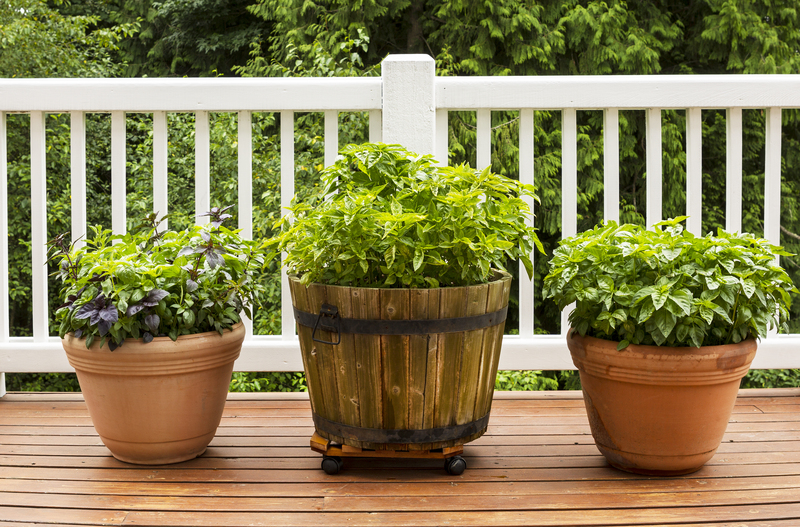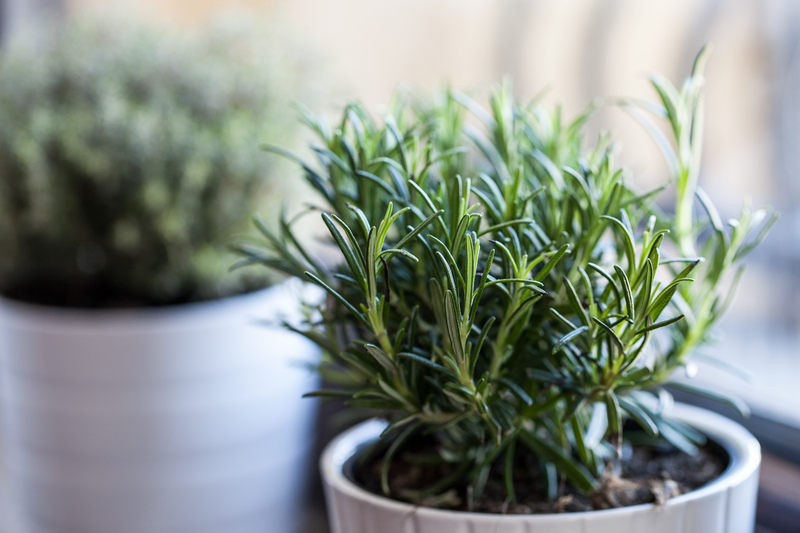Building an Enchanting Herb Refuge
Posted on 24/05/2025
Building an Enchanting Herb Refuge: The Ultimate Guide
Transform your garden into a magical sanctuary with an enchanting herb refuge. Whether you are a passionate gardener, a culinary explorer, or simply someone who enjoys nature's serenity, constructing a dedicated area for herbs not only boosts the beauty and biodiversity of your outdoor space but also enhances your well-being. This comprehensive guide explores everything you need to know about creating an aromatic, educational, and tranquil herb oasis right at home.

Why Create a Magical Herb Haven?
Before diving into the process, let's understand why building an enchanting herb refuge is more relevant than ever:
- Health and Wellness: Herbs have been used for centuries for their healing properties - both culinary and medicinal.
- Ecological Benefits: Cultivating herbs supports pollinators, improves soil health, and provides a diverse ecosystem.
- Personal Sanctuary: Escape the hustle and bustle by retreating to your own aromatic, calming corner.
- Educational Opportunities: Herb refuges are ideal for learning about plants, gardening techniques, and sustainability.
- Aesthetic Appeal: Herb gardens bring beauty, texture, and enchanting scents to any landscape.
Ready to transform your garden into a magical herb refuge? Let's walk through the essential steps to create your enchanting herb sanctuary.
Step 1: Designing Your Herb Refuge
Choose the Best Location
- Sunlight: Most herbs thrive in full sun (at least 6-8 hours daily). Observe your garden and pick a spot with plenty of light.
- Accessibility: Place your herb haven where you can easily access it daily, both for harvesting and maintenance.
- Protection: Find an area shielded from strong winds and harsh weather to help your herbs flourish.
Decide on the Shape and Size
- Herb refuges can be formal (geometric patterns, raised beds) or informal (meandering paths, mixed borders).
- Consider thematic layouts: Try a spiral, a circular fairy ring, or a whimsical labyrinth to add mystique to your herb preserve.
- Size can range from a few pots on a balcony to sprawling beds in a backyard.
Tip: Use paths and borders made of stone, gravel, or reclaimed wood to define your magical herb escape and make navigation magical and practical!
Step 2: Choosing Enchanting Herbs
Main keyword variations include "herb oasis," "herb sanctuary," and "aromatic herb retreat." No matter which you prefer, picking a diverse mix of herbs is the key to creating a truly enchanting and versatile refuge.
Enchanting Culinary Herbs
- Basil: Fresh scent, delicious in Italian and Thai dishes.
- Rosemary: Woody fragrance, excellent for roasts and bread.
- Thyme: Versatile, aromatic, hardy in different climates.
- Sage: Earthy, perfect for Mediterranean recipes.
- Chives: Mild onion flavor, beautiful purple flowers in spring.
Magical Medicinal Herbs
- Lavender: Calming aroma, useful for teas, sachets, and skin care.
- Mint: Refreshing, fast growing, attracts bees and butterflies.
- Lemon Balm: Lemon-scented, traditionally used for relaxation.
- Chamomile: Apple-like scent, soothing for teas and sleep pillows.
- Echinacea: Stunning flowers, boosts immunity and attracts pollinators.
Enchanting Ornamental and Pollinator-Friendly Herbs
- Bee Balm (Monarda): Attracts hummingbirds, bees, and butterflies.
- Fennel: Feathery foliage, beautiful yellow blossoms.
- Borage: Blue star-shaped flowers, edible and loved by pollinators.
- Yarrow: Ferny leaves, clusters of colorful blooms.
Blend a variety of these herbs for a garden that is not only lush and beautiful but also of practical use throughout the year!
Step 3: Preparing the Soil for a Thriving Herb Oasis
Soil Quality
Most herbs thrive in well-drained, loose, and slightly alkaline soil. Here's how to prepare your soil:
- Test pH level (ideal is about 6.5-7.0 for most herbs).
- Mix in organic compost to improve nutrients and structure.
- Add sand or grit to enhance drainage, especially for Mediterranean herbs.
- Avoid heavy clay soils--herbs hate waterlogged roots!
Raised Beds and Containers
For areas with poor soil, build raised beds or use large pots and planters. These not only improve drainage but can add a structured, magical look to your herb sanctuary.
Step 4: Planting and Arranging Your Magical Herb Sanctuary
Herb Placement
- Height: Place tall herbs like fennel and rosemary at the back or center, with shorter ones like thyme and oregano at the edges.
- Spread: Give each plant enough space to grow and thrive.
- Companion Planting: Combine herbs that benefit each other and repel pests (e.g., basil and tomatoes, chives and carrots).
Creating Magical Pathways
Add winding stone paths, mosaic stepping stones, or rustic wooden planks to invite exploration and create a sense of journey through your enchanting herb refuge.
Themed Corners and Features
- Meditation Glade: Plant lavender, chamomile, and mint around a secluded bench.
- Tea Garden: Dedicate a section to herbs like lemon balm, peppermint, and chamomile.
- Pollinator Patch: Cluster bee balm, borage, and yarrow with colorful annuals.
Personalize your herb oasis with statues, fairy lights, or a bubbling water feature to enhance its enchanting atmosphere.
Step 5: Nurturing Your Enchanting Herb Refuge
Watering Tips
- Water deeply but infrequently; let the soil dry out slightly between waterings.
- Early morning is the best time for watering to prevent mildew and evaporation loss.
- Mulch with bark chips, straw, or gravel to retain moisture and suppress weeds.
Pruning and Harvesting
- Trim herbs regularly to encourage bushy growth and prevent flowering (which often alters flavor).
- Harvest leaves in the morning for peak flavor and aroma.
- Dry or freeze surplus herbs for use year-round.
Pest and Disease Management
- Encourage beneficial insects by planting flowers and avoiding chemicals.
- Handpick pests or use gentle organic sprays if necessary.
- Rotate herbs and maintain garden hygiene to prevent build-up of diseases.
Step 6: Enjoying the Magic of Your Herb Sanctuary
Herbs for the Senses
- Sight: Enjoy the ever-changing tapestry of leaf shapes, flower colors, and textures.
- Smell: Brush past basil, mint, or thyme for an instant blast of fragrance.
- Taste: Infuse your cooking and teas with homegrown herbs bursting with flavor.
- Touch: Many herbs, like lamb's ear and lemon balm, have uniquely tactile leaves.
- Sound: Let bees, butterflies, and birds add a living symphony to your oasis.
Creative Uses for Homegrown Herbs
- Craft fresh bouquets for the table or gifts for loved ones.
- Make your own herbal teas, bath sachets, and sleep pillows.
- Create homemade herbal oils, vinegars, and butters.
- Host memorable garden parties in your magical herb garden.
Bonus Tips for the Ultimate Herb Oasis
- Label Your Herbs: Use whimsical signs, painted rocks, or engraved markers to keep track of varieties and add charm.
- Incorporate Edible Flowers: Add marigolds, nasturtiums, or violets for extra color and culinary possibilities.
- Nighttime Enchantment: String solar fairy lights or lanterns along paths for gentle illumination and ambiance.
- Wildlife Watering Station: Add a shallow bird bath or bee watering dish to support your garden's bustling ecosystem.

Common Questions About Creating a Magical Herb Refuge
Can I build an enchanting herb retreat in a small space?
Absolutely! Even a few pots on a patio or windowsill can become a lush, enchanting herb oasis. Choose compact varieties and maximize vertical space with shelves or hanging planters.
What herbs are best for beginners?
Basil, mint, chives, oregano, thyme, and parsley are easy to grow, versatile, and hardy--ideal for starting your herb sanctuary journey.
How do I keep my herb refuge enchanting in winter?
Bring tender herbs indoors, use protective mulches, and add evergreen herbs like rosemary or bay laurel for year-round magic. Plan winter luminaries or lanterns to maintain enchanting vibes even in the colder months.
Can I mix herbs with vegetables and flowers?
Yes! Interplanting with veggies and blooms enhances your garden's beauty, utility, and biodiversity--just ensure each plant's sunlight and water needs are compatible.
Conclusion: Start Your Magical Herb Journey Today!
Building an enchanting herb refuge--whether you call it an herb oasis, magical herb sanctuary, or aromatic retreat--offers countless rewards. From providing culinary delights and home remedies to supporting biodiversity and offering a place for meditation, your new herb haven will be a source of enchantment all year round.
Embark on your magical gardening adventure today and share the joy by inviting friends, family, or community members to experience the wonder of your very own enchanting herb refuge!

